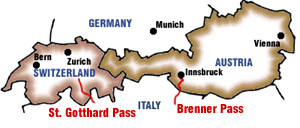
|

|

|

|
A report on the evidence and the questions that remain.
By David Marks, Associate Producer, BBC/FRONTLINE
|
When we started research for our documentary "Nazi Gold," we knew that the emotionally-charged issue of Holocaust survivors' claims against Swiss banks was triggering a re-examination of Switzerland's relations with Nazi Germany. New accounts of witnesses and survivors, and information from recently declassified documents in the United States and Switzerland, contradicted the previously-accepted historical record. From Switzerland's close trade and banking relations with Berlin, to its controversial and tragic refugee policy, to certain officials' post-war support for Nazis in their escape to South America, wartime Switzerland appears to many observers to have been less than neutral in World War II.
But there is one story we examined -- the forced transports of Italians through Switzerland via the St. Gotthard mountain passage -- which represents a dramatic new allegation about Switzerland's wartime role. We tracked down a woman able to describe in detail an incident that since 1943 had been discussed only behind closed doors within Zurich's Jewish community. Initially, this woman - whom we call 'Elizabeth' - had contacted a Holocaust survivor who had written about Switzerland's role in the war. She described to him how, as a teenager in Zurich, she assisted in giving humanitarian aid to people in cattle trains headed to Germany.
We eventually established communication with 'Elizabeth' directly and gained her trust. She asked that we guarantee her privacy before giving an interview. Her husband confirmed that this was a story she had told him for the first time over 40 years ago. She is an intelligent, kind and cheerful woman with no motive for telling her story except a desire to put on record what she witnessed.
|

|

|
'Elizabeth' claimed that her experience with Nazi prisoner transports occurred sometime after the middle of December 1943. She emphasized that this was very secret, telling us, "I think the whole thing was rather undercover." And she added, "we knew they were going to Germany, we knew they were Jews, we knew about the concentration camps." In our interview with her, she described harrowing scenes at Zurich's main station, with details we set out to corroborate.
The question is - who were on the trains? Were they Jews on their way to concentration camps, or slave laborers seized by the Nazis in Italy to keep their factories running? Or was it possible the transports included both?
To start, we found witnesses whose stories do support the charge that Italians were forcibly sent through Switzerland.
Elena Dreher, an Italian partisan, described her unit's attempts to stop freight trains loaded with people before they passed into Switzerland. She recalled how the Germans would round up Italians in towns and villages by offering free cigarettes to all men between 18 and 40. They would be arrested and shipped to Germany as slave laborers; many would be worked to their deaths. The partisans attempted to stop these transports and were occasionally successful in derailing trains before they reached the Swiss border.
Otto Frey, a Swiss railway supervisor told us how he helped arrange for trains with cattle cars full of Italians to be transported against their will through Swiss territory. He emphasized, "We were told to get the trains through Switzerland as quickly as possible." We heard similar accounts from five additional retired trainmen, including one description of a train that was stopped by rail workers within Switzerland, so the people inside could escape.
We found material in the U.S. National Archives on use of the Swiss rail system by the Germans. There were U.S. intelligence documents from the war which confirmed a massive amount of traffic through the Gotthard mountain passage between 1943 and 1944. German trains with coal and non-strategic supplies for Italy were passing through Switzerland at the rate of up to one every ten minutes. There have also been on-the-record accounts of hidden weapons and soldiers on the same route including a report by Jean Ziegler, a radical Swiss parliamentarian, who, as a young man claims to have witnessed a derailed freight train in 1944 with weapons and Nazi soldiers giving orders: an incident that, officially, never took place.
As for neutral Switzerland's government policy on railway passage through the country, this was based on the German-Italian-Swiss treaty of 1909, which established use of the Gotthard Tunnel. It remained the instrument by which traffic was regulated and justified until the end of the war. But soldiers and weapons were officially forbidden. The Nazis used the Brenner pass in Austria for the majority of military transports to the Italian front.
|

|
 |

|
| |
However, as U.S. archives confirm, the Brenner was bombed heavily in December of 1943 and effectively closed through the beginning of January. Additionally, weather records from that time report heavy early snowfalls that would have delayed or stopped train traffic in that time period. In the post-war interrogation of the German Ambassador to Bern by the Americans, he stated that "the Swiss progressively increased the number of articles that could not cross their frontier," but confirmed that short-term agreements on specific "transactions" related to the Gotthard passage were made through the summer of 1944. The Germans had been shipping the contents of entire Italian factories north since their invasion of Italy. As late as January 2, 1945, Allan Dulles, head of the OSS in Bern, stated in a memo that he saw "no objection to bombing attacks on Italian end of Gotthard line..." implying the continued strategic importance of the route.
In Italy, we were helped by the Center for Documentation on Contemporary Jewish History, which has gathered much information on Italian Jews sent north after the German invasion of Italy. Researchers confirmed hearing unsubstantiated stories that the Nazis had sent Jewish prisoners to concentration camps through Switzerland. Yet trains with over 9000 Jews that went from Italy to Auschwitz are known to have gone through the Brenner or Taravisio -- to the east. Transports to other concentration camps are undocumented. We were referred to historians who had expertise in the rounding up of partisans, the German occupation of Italy and the capture and use of slave laborers.
|

|

|
There is extensive data on the use of Italian slave laborers by the Nazis. After the fall of Mussolini, there was a wave of revenge against the Italians. Italians who were already in Germany were turned into slaves. Between September of 1943 and April of 1944 a minimum of 23,000 Italians, many former soldiers, were deported to Germany to work as slaves in German industry. Additionally, over 10,000 partisans were captured and deported during the same period. By 1944 there were over half a million Italians working for the Nazi war machine.
Estimates of the total number of deported Italian Jews, partisans, and soldiers are not exact. And although it is known that many were transported through Austria, there was no information from historians or archives outside of Switzerland that could account for all transports or would directly contradict the information described in our interview.
'Elizabeth' told us that the initial approach to the Jewish community in Zurich to give aid to people on the train was organized by the Swiss Red Cross. We asked them to search their records. A Red Cross historian looked for documents indicating any assistance given to prisoners transported by train through Swiss territory during the war. Although his search continues, his initial survey of wartime Red Cross reports and minutes from executive meetings made no reference to the transports described in our interview or to any aid to Italian forced laborers. Independently, we found documents showing that a Swiss Red Cross representative was in contact with German commanders in northern Italy in January of 1944, "co-ordinating help for the Italian population." Also, the Swiss government repeatedly requested the Zurich Jewish community to provide for Jewish refugees arriving in Switzerland.
Swiss railways told us that when their offices were moved in the 1960s all records of train scheduling and movements during the war were destroyed.
Correspondence in government archives in Bern had direct references to transport of Italians. German requests that trains carrying Italian laborers be allowed though Switzerland continued through October of 1943. Swiss railways responded that although they would not provide the trains, they had "no objections to the transports being carried out." The Swiss government apparently made no final decision. But the chief of police, Heinrich Rothmund, in a memo on September, 22 1943, is aware that transports are resuming at the rate of 3-5 trains per day. Also, in October of 1943, an Allied radio broadcast reported that a freight train on its way through Switzerland had been stopped with Italians slave laborers on board who were liberated. The Swiss government denied the report and called it propaganda, claiming that no transports of Italian workers had gone through since July of 1943. In a letter to the government from a concerned citizen kept in the same file, the writer states that the Swiss people involved "in serving the German war machine, will one day have to atone for this anti-Christian conduct."
Evidence that slave labor trains transited Switzerland is conclusive, but what about claims that Jews on their way to concentration camps also went through Switzerland?
After months of investigation we found three witnesses who told approximately the same story. They were extremely nervous; one aggressively terminated all contact with us on the grounds we were reviving the ghosts of a dark and shameful era. But the essence of all three stories - plus our interview with 'Elizabeth' - was the same: long trains with sealed cattle wagons rolling into Zurich Hauptbahnhof in the middle of the night, carrying Italian Jews and other prisoners north.
We were not able to locate anyone who may have been on forced transports through Switzerland during the war. There is additional investigative work that can be done with the co-operation of the Swiss, German and Italian governments. But this investigation raises new disturbing questions about Swiss neutrality. And, along with other elements of our documentary "Nazi Gold," the accounts of these transports may dramatically change the previously accepted history of wartime Switzerland.
|
| home . reactions . the train . neutral or afraid? . readings . seeking wartime bank accounts . map . chronology . status of the investigations . tapes & transcripts . press explore FRONTLINE . pbs online
web site copyright WGBH educational foundation

| |